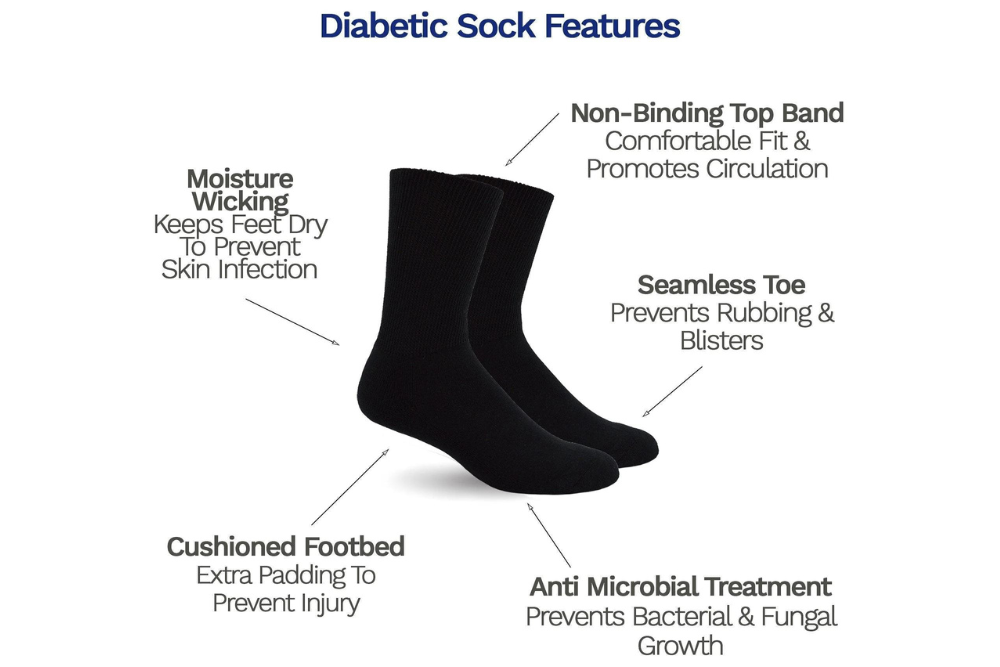Introduction
In recent years, the prevalence of diabetes has surged globally, bringing with it a heightened awareness of the complications associated with the disease. Among these complications, foot care stands out as a critical area that requires special attention. For individuals with diabetes, maintaining foot health is not just a matter of comfort but a necessity to avoid serious issues such as ulcers, infections, and, in severe cases, amputations. This need has created a growing demand for products specifically designed to protect diabetic feet, with diabetic long socks being one of the most essential items.
For wholesalers, this presents a lucrative opportunity. Diabetic long socks are not just another product on the shelf; they are a necessity for a large and expanding market. With the right strategies, wholesalers can capitalize on this demand and achieve significant sales growth. In this comprehensive guide, we will explore the key strategies to maximize sales in the diabetic long socks wholesale market, helping you establish a strong foothold in this niche yet rapidly growing industry.
Understanding the Importance of Diabetic Long Socks
Before diving into the sales strategies, it’s essential to understand the importance of diabetic long socks and why they are in such high demand. Diabetes can lead to various complications, including peripheral neuropathy (nerve damage) and peripheral arterial disease (poor circulation). Both conditions increase the risk of foot injuries, which can lead to severe infections if not properly managed.
Key Features of Diabetic Long Socks:
- Non-Binding Tops: Unlike regular socks, diabetic long socks feature non-binding tops that do not constrict the legs. This design is crucial for promoting healthy blood circulation, which is often compromised in diabetic patients.
- Seamless Construction: Diabetic long socks are typically seamless to reduce the risk of irritation and blisters, which can quickly develop into ulcers in diabetic patients.
- Moisture-Wicking Material: These socks are made from moisture-wicking materials to keep the feet dry, reducing the risk of fungal infections and skin breakdown.
- Extra Cushioning: Diabetic long socks often come with extra padding to protect the feet from pressure points and to provide additional comfort.
By understanding these features, wholesalers can better communicate the value of diabetic long socks to their customers, ensuring they are positioned as a must-have item for diabetic foot care.
Identifying and Targeting the Right Market Segments

To maximize sales in the diabetic long socks market, it’s crucial to identify and target the right customer segments. Unlike more general products, diabetic long socks cater to a specific demographic: individuals with diabetes who are aware of the importance of foot care. However, within this demographic, there are several key market segments that wholesalers should focus on.
1. Healthcare Providers and Institutions
Healthcare providers, including hospitals, clinics, and long-term care facilities, are significant buyers of diabetic long socks. These institutions require large quantities of diabetic socks for their patients, making them ideal customers for wholesale businesses. Establishing partnerships with healthcare providers can lead to steady, recurring orders.
2. Pharmacies and Medical Supply Stores
Pharmacies and medical supply stores are another crucial market segment. These outlets often serve as the first point of contact for diabetic patients seeking foot care products. By stocking diabetic long socks, they cater to a specific need within their customer base. Wholesalers can benefit from establishing strong relationships with these retailers, offering them competitive pricing and product variety.
3. Retail Chains and E-commerce Platforms
Retail chains and online marketplaces represent a significant opportunity for wholesalers. While these platforms may cater to a broader audience, they also include customers looking for specialized products like diabetic long socks, diabetic Work Socks. E-commerce, in particular, has seen tremendous growth, with consumers increasingly turning to online shopping for their healthcare needs. Wholesalers can tap into this trend by supplying diabetic long socks to popular e-commerce platforms.
4. Specialty Diabetic Care Stores
Specialty stores that focus on diabetic care products are a natural fit for diabetic long socks. These stores often have a dedicated customer base of individuals with diabetes who are looking for high-quality, reliable products. Wholesalers can work closely with these stores to ensure a steady supply of diabetic long socks that meet the specific needs of their customers.
By understanding these market segments and tailoring their approach to each, wholesalers can maximize their reach and sales potential in the diabetic long socks market.
Diversifying Your Product Range
Offering a diverse range of products is a proven strategy for maximizing sales in any wholesale market, and diabetic long socks are no exception. While the basic design and functionality of diabetic long socks are consistent, there are several ways wholesalers can diversify their product offerings to attract a broader customer base.
1. Varied Sizes and Lengths
While diabetic long socks are typically designed to be knee-high, there are opportunities to offer variations in length, such as mid-calf or over-the-knee options. Additionally, offering a wide range of sizes ensures that customers can find the perfect fit, which is crucial for comfort and effectiveness.
2. Gender-Specific Designs
Though diabetic long socks are generally unisex, offering gender-specific designs can appeal to different customer preferences. Men’s and women’s diabetic socks can be designed with subtle differences in style, color, and fit, catering to the unique needs of each gender.
3. Seasonal Varieties
Another way to diversify your product range is by offering seasonal varieties. For instance, thicker, insulated socks for winter and lighter, breathable options for summer can help meet the varying needs of diabetic patients throughout the year. This also encourages repeat purchases as customers look for socks that suit the current season.
4. Special Features and Innovations

To stand out in the market, wholesalers can offer diabetic long socks with special features or innovations. This could include antimicrobial treatments to prevent infections, extra cushioning for added comfort, or even compression options for patients who require additional support. By staying ahead of trends and offering innovative products, wholesalers can differentiate themselves from competitors.
Diversifying your product range not only attracts a wider audience but also encourages existing customers to purchase multiple products, ultimately driving up sales.
Conclusion:
The diabetic long socks market presents a unique and profitable opportunity for wholesalers to tap into a growing demand for specialized healthcare products. By understanding the critical features of diabetic long socks and their importance in diabetic foot care, wholesalers can effectively position these products as essential items for their customers.
Targeting the right market segments—such as healthcare providers, pharmacies, retail chains, and specialty stores—ensures that your products reach those who need them most. Additionally, by diversifying your product range and offering innovative features, you can cater to a broader audience and encourage repeat purchases.
Success in this market requires more than just offering a product; it involves building strong relationships with suppliers and retailers, understanding customer needs, and staying ahead of industry trends. By implementing these strategies, wholesalers can maximize sales, establish a strong presence in the market, and contribute to the well-being of individuals with diabetes.